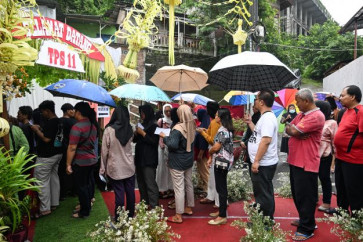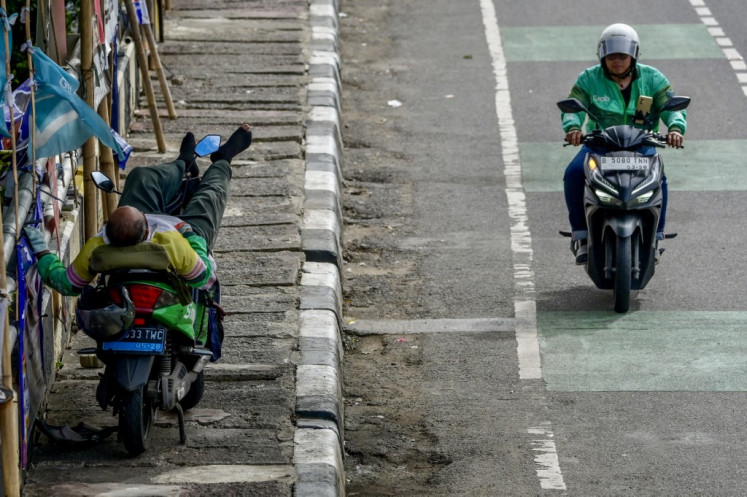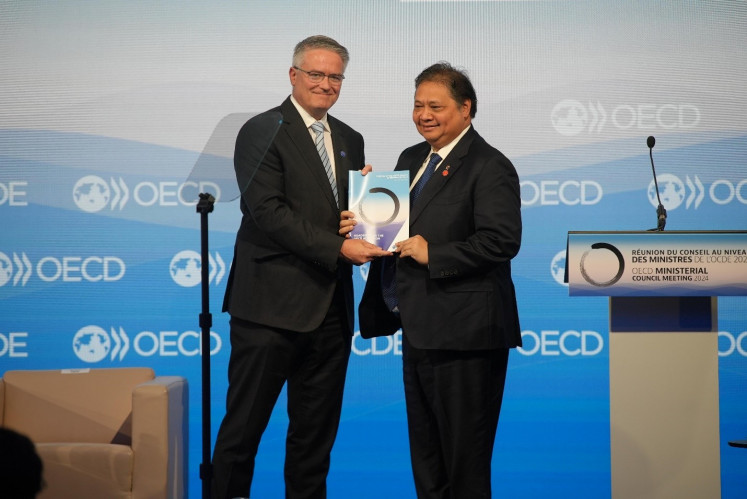Biennale aims to inspire innovation in RI's design and craft
Sesame Alley: Gang Sesama (Sesame Alley) is designed to fit narrow alleys in crowded cities
Change Size
 Sesame Alley: Gang Sesama (Sesame Alley) is designed to fit narrow alleys in crowded cities. Made of repurposed materials like used metal containers, the works are created by architect Susan Ginting, interior designer Francis Surjaseputra and fiber artist Biranul Anas Zaman. (Courtesy of Indonesia Design and Craft Biennale)" border="0" height="333" width="500">Sesame Alley: Gang Sesama (Sesame Alley) is designed to fit narrow alleys in crowded cities. Made of repurposed materials like used metal containers, the works are created by architect Susan Ginting, interior designer Francis Surjaseputra and fiber artist Biranul Anas Zaman. (Courtesy of Indonesia Design and Craft Biennale)
Sesame Alley: Gang Sesama (Sesame Alley) is designed to fit narrow alleys in crowded cities. Made of repurposed materials like used metal containers, the works are created by architect Susan Ginting, interior designer Francis Surjaseputra and fiber artist Biranul Anas Zaman. (Courtesy of Indonesia Design and Craft Biennale)" border="0" height="333" width="500">Sesame Alley: Gang Sesama (Sesame Alley) is designed to fit narrow alleys in crowded cities. Made of repurposed materials like used metal containers, the works are created by architect Susan Ginting, interior designer Francis Surjaseputra and fiber artist Biranul Anas Zaman. (Courtesy of Indonesia Design and Craft Biennale)The first Indonesia Design and Craft Biennale 2013 at the National Gallery presents more than 100 works by Indonesian designers and artists, showcasing a wide array of styles, ideas and aesthetic tastes.
Initiated by the Tourism and Creative Economy Ministry, the first biennale, which runs for a month from Dec. 19, exhibits works by eight creative economy sectors: fashion, interior design, textiles, product design, graphic design, architecture, furniture and crafts.
Latest ministry data shows that of all creative economy sectors including film, visual arts, music and performing arts, these eight are responsible for 70 percent of gross domestic product from the creative economy.
Taking the theme GeoEthnic, the biennale involves 93 designers and artists from the sectors, of which 53 show individual works and the remaining 13 being collaborations.
âThe curatorial process took more than a year. We have selected works that are inspiring and products that havenât been in the market or shown to the public,â curatorial team head Irvan Noeâman said. âWe also asked the artists and designers to incorporate an Indonesian element in their works.â
 Indonesiaâs new art: Titled Rebirth, the work is made by fashion designer Susan Budiharjo, product designer Gilang Luhur Mandiri and interior designer Uy Dharma Prayoga. (Courtesy of Indonesia Design and Craft Biennale)
Indonesiaâs new art: Titled Rebirth, the work is made by fashion designer Susan Budiharjo, product designer Gilang Luhur Mandiri and interior designer Uy Dharma Prayoga. (Courtesy of Indonesia Design and Craft Biennale)
The highlight of the biennale is the collaborations, which are exhibited in the main hall of the gallery. The collaborations between different fields were encouraged by the curatorial team and by the steering committee.
Architects like Andra Matin, Yu Sing, Yoshi Fajar Kresna Murti and Sarah Ginting collaborated with graphic designer Hermawan Tanzil, videomaker Adi Panuntun, product designer Mizan Allan de Neve and interior designer Francis Surjaseputra. Craft artists Timbul Rahardjo and Kahfiati Kahdar collaborated with textile designer Gamia
Dewanggamanik and industrial designer Joshua Simandjuntak.
The theme GeoEthnic was chosen because the committee wanted Indonesia to contribute to global design and art. âTheme is important in the biennale to show the spirit at the time of the biennale being held,â the press release said. âAs world citizens who share Earth with other citizens, we have to contribute something to the world. The fact that Indonesia comprises more than 600 ethnic groups is a potential asset for the growth of the countryâs design and creative industry.â
What sets this biennale apart from other design events is that the ministryâs Design and Craft Biennale wants to be an event that provides âtrend forecastingâ and the âtrend decodingâ of the past two years, the committee said in the release.
The results are a wide range of interpretations of GeoEthnic. The gallery shows works that immediately evoke the word âethnicâ, such as those made of bamboo and rattan or batik and other well-known ethnic mediums. However, even those that immediately look ethnic are creative and innovative and not based on a simple âmimicryâ of existing local wisdom.
One of the steering committee members, architecture writer Imelda Akmal, said that although the theme was ethnic, âmimicryâ was something the biennale wanted to avoid.
 Sesame Alley: <)
Sesame Alley: <)
S
span class="inline inline-none">Sesame Alley: Gang Sesama (Sesame Alley) is designed to fit narrow alleys in crowded cities. Made of repurposed materials like used metal containers, the works are created by architect Susan Ginting, interior designer Francis Surjaseputra and fiber artist Biranul Anas Zaman. (Courtesy of Indonesia Design and Craft Biennale)
The first Indonesia Design and Craft Biennale 2013 at the National Gallery presents more than 100 works by Indonesian designers and artists, showcasing a wide array of styles, ideas and aesthetic tastes.
Initiated by the Tourism and Creative Economy Ministry, the first biennale, which runs for a month from Dec. 19, exhibits works by eight creative economy sectors: fashion, interior design, textiles, product design, graphic design, architecture, furniture and crafts.
Latest ministry data shows that of all creative economy sectors including film, visual arts, music and performing arts, these eight are responsible for 70 percent of gross domestic product from the creative economy.
Taking the theme GeoEthnic, the biennale involves 93 designers and artists from the sectors, of which 53 show individual works and the remaining 13 being collaborations.
'The curatorial process took more than a year. We have selected works that are inspiring and products that haven't been in the market or shown to the public,' curatorial team head Irvan Noe'man said. 'We also asked the artists and designers to incorporate an Indonesian element in their works.'

The highlight of the biennale is the collaborations, which are exhibited in the main hall of the gallery. The collaborations between different fields were encouraged by the curatorial team and by the steering committee.
Architects like Andra Matin, Yu Sing, Yoshi Fajar Kresna Murti and Sarah Ginting collaborated with graphic designer Hermawan Tanzil, videomaker Adi Panuntun, product designer Mizan Allan de Neve and interior designer Francis Surjaseputra. Craft artists Timbul Rahardjo and Kahfiati Kahdar collaborated with textile designer Gamia
Dewanggamanik and industrial designer Joshua Simandjuntak.
The theme GeoEthnic was chosen because the committee wanted Indonesia to contribute to global design and art. 'Theme is important in the biennale to show the spirit at the time of the biennale being held,' the press release said. 'As world citizens who share Earth with other citizens, we have to contribute something to the world. The fact that Indonesia comprises more than 600 ethnic groups is a potential asset for the growth of the country's design and creative industry.'
What sets this biennale apart from other design events is that the ministry's Design and Craft Biennale wants to be an event that provides 'trend forecasting' and the 'trend decoding' of the past two years, the committee said in the release.
The results are a wide range of interpretations of GeoEthnic. The gallery shows works that immediately evoke the word 'ethnic', such as those made of bamboo and rattan or batik and other well-known ethnic mediums. However, even those that immediately look ethnic are creative and innovative and not based on a simple 'mimicry' of existing local wisdom.
One of the steering committee members, architecture writer Imelda Akmal, said that although the theme was ethnic, 'mimicry' was something the biennale wanted to avoid.

Other works drew inspiration from Indonesian things and made something else out of them: a tea set inspired by the traditional method of wrapping food by ceramics artist Ahadiat Joedawinata, a wooden architectural structure inspired by a traditional snack from Siborongborong, North Sumatra by architect Ramadhoni Dwi Payana and a set of interior panels with motifs inspired by Balinese janur (woven young coconut leaves) by interior designer Rudy Dodo.
Others show innovative thinking out of everyday things like a lamp shade made of small bags of krupuk (crackers) by Irwan Ahmett in an informal collaboration with Mas Anto and Kang Lilik, owners of a snack stall in Jakarta.
Andra and Hermawan made an open source design template of a home for stray cats: Rumah Kucing Garong. People who like cats but do not want to keep them as pets in their houses can access the design template and building instructions at Facebook page Rumah Kucing Garong, Twitter handle @RKucingGarong and Instagram account rumahkucinggarong.
'We created an easy to copy design made of easy to find materials like repurposed wood,' said Hermawan, the founder of Leboye design house and DiaLoGue art space. 'Anyone can download our design and make Rumah Kucing Garong for their own neighborhood.'
Hermawan said they had tested the cat house in a park near Andra's house. 'It is a popular facility among the stray cats there.'
Biennale Desain & Kriya Indonesia
Dec. 19, 2013 to Jan. 19, 2014
Galeri Nasional Indonesia
Jl. Medan Merdeka Timur No. 14
Central Jakarta









